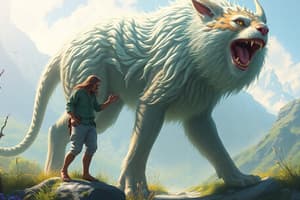Podcast
Questions and Answers
What drives human-selected crops in contrast to natural selection?
What drives human-selected crops in contrast to natural selection?
- Geographical changes
- Environmental pressures
- Random mutations
- Human choice (correct)
Intraspecific competition occurs between different species.
Intraspecific competition occurs between different species.
False (B)
What is the relationship between predators and prey known as?
What is the relationship between predators and prey known as?
Predator-Prey Relationship
Competition that leads to adaptations or resource partitioning is known as ______.
Competition that leads to adaptations or resource partitioning is known as ______.
Match the following types of competition with their definitions.
Match the following types of competition with their definitions.
Which of the following is NOT a component of natural selection?
Which of the following is NOT a component of natural selection?
Adaptations can only be structural and physiological.
Adaptations can only be structural and physiological.
What is the definition of evolution?
What is the definition of evolution?
Natural selection acts upon the variation in ______ among individuals.
Natural selection acts upon the variation in ______ among individuals.
Match the following mechanisms of evolution with their definitions:
Match the following mechanisms of evolution with their definitions:
Which type of adaptation is a cactus's thick skin an example of?
Which type of adaptation is a cactus's thick skin an example of?
Gene flow can occur only through natural processes like migration.
Gene flow can occur only through natural processes like migration.
What is the outcome of genetic drift in small populations?
What is the outcome of genetic drift in small populations?
Flashcards are hidden until you start studying
Study Notes
Natural Selection
- Definition: A mechanism by which organisms with favorable traits are more likely to survive and reproduce, passing those traits to offspring.
- Key Components:
- Variation: Differences in traits among individuals within a population.
- Heritability: Traits must be passed down from one generation to the next.
- Differential Survival: Individuals with advantageous traits survive and reproduce at higher rates.
- Example: Peppered moths changing color during the Industrial Revolution due to pollution.
Variation
- Definition: Differences in physical or behavioral traits among individuals of the same species.
- Sources:
- Genetic Mutations: Changes in DNA that can introduce new traits.
- Environmental Factors: Influences such as climate, food availability, and habitat can affect traits.
- Importance: It provides the raw material for natural selection to act upon.
Adaptation
- Definition: Traits that enhance an organism's ability to survive and reproduce in a specific environment.
- Types:
- Structural: Physical features (e.g., beak shape in birds).
- Behavioral: Actions taken by organisms (e.g., migration patterns).
- Physiological: Internal processes (e.g., temperature regulation).
- Example: Cacti have thick skin and spines to conserve water in arid environments.
Evolution
- Definition: The change in inherited characteristics of biological populations over generations.
- Mechanisms:
- Natural Selection
- Mutation: Random changes in DNA that can introduce new traits.
- Genetic Drift: Random changes in allele frequencies, especially in small populations.
- Gene Flow: Movement of genes between populations through migration.
- Outcome: Can lead to speciation, where new species arise from existing ones.
Artificial Selection
- Definition: The intentional breeding of organisms by humans for specific traits.
- Examples:
- Domesticated animals: (e.g., dogs bred for specific behaviors or appearances).
- Crop plants: Selected for increased yield, taste, or disease resistance.
- Contrast with Natural Selection: Driven by human choice rather than environmental pressures.
Competition
- Definition: The struggle between organisms for limited resources such as food, space, and mates.
- Types:
- Intraspecific Competition: Competition within the same species.
- Interspecific Competition: Competition between different species.
- Effects on Populations: Can lead to adaptations, resource partitioning, or changes in population dynamics.
Predator-Prey Relationship
- Definition: An ecological interaction where one organism (the predator) hunts another (the prey).
- Dynamics:
- Regulation: Predators help regulate prey populations, preventing overpopulation.
- Adaptations: Prey develop adaptations (e.g., camouflage, speed) to evade predators.
- Co-evolution: As prey evolve defenses, predators may evolve better hunting strategies.
- Example: Wolves hunting deer; an increase in wolves may lead to a decrease in deer population and vice versa.
Studying That Suits You
Use AI to generate personalized quizzes and flashcards to suit your learning preferences.




